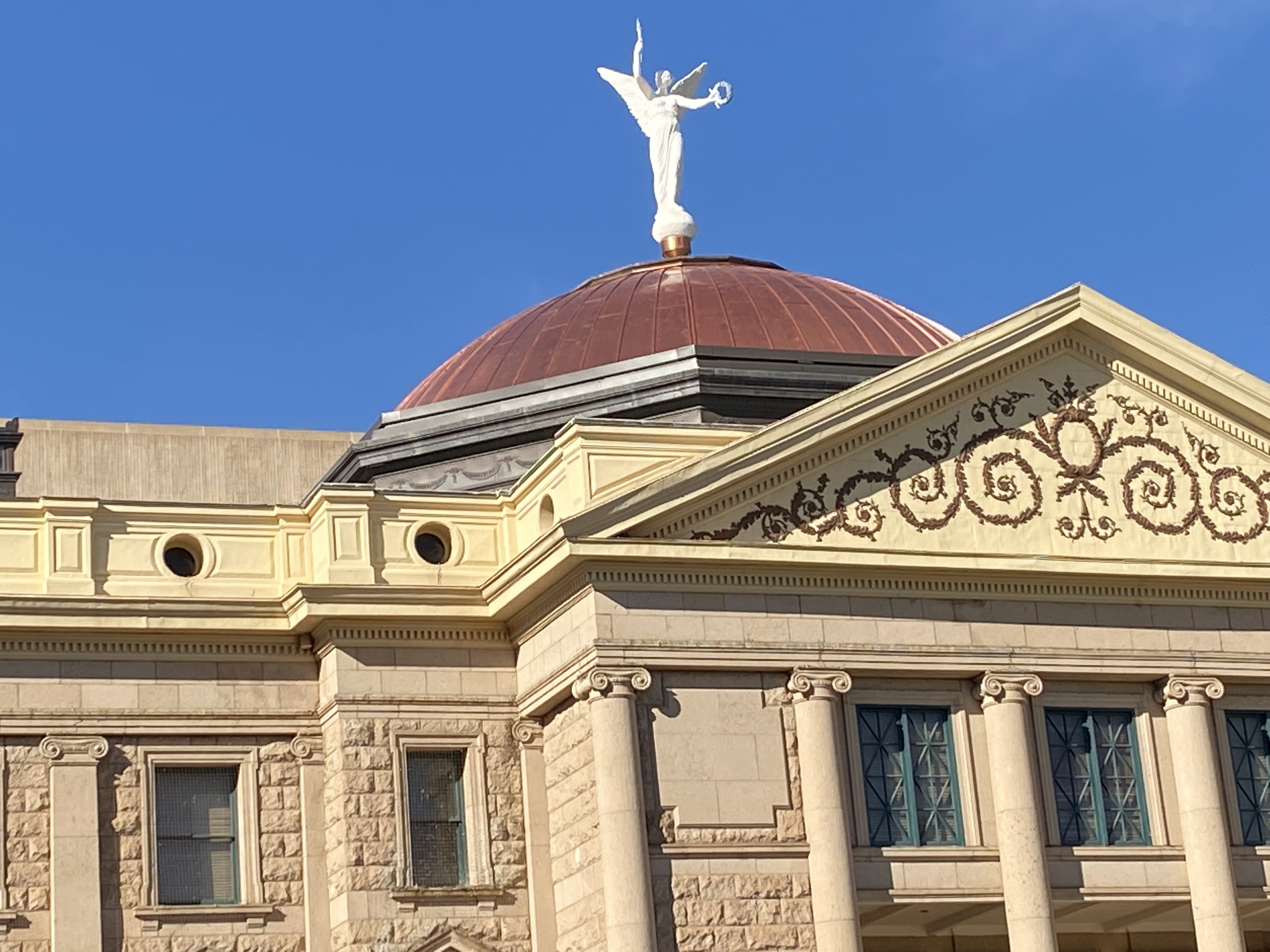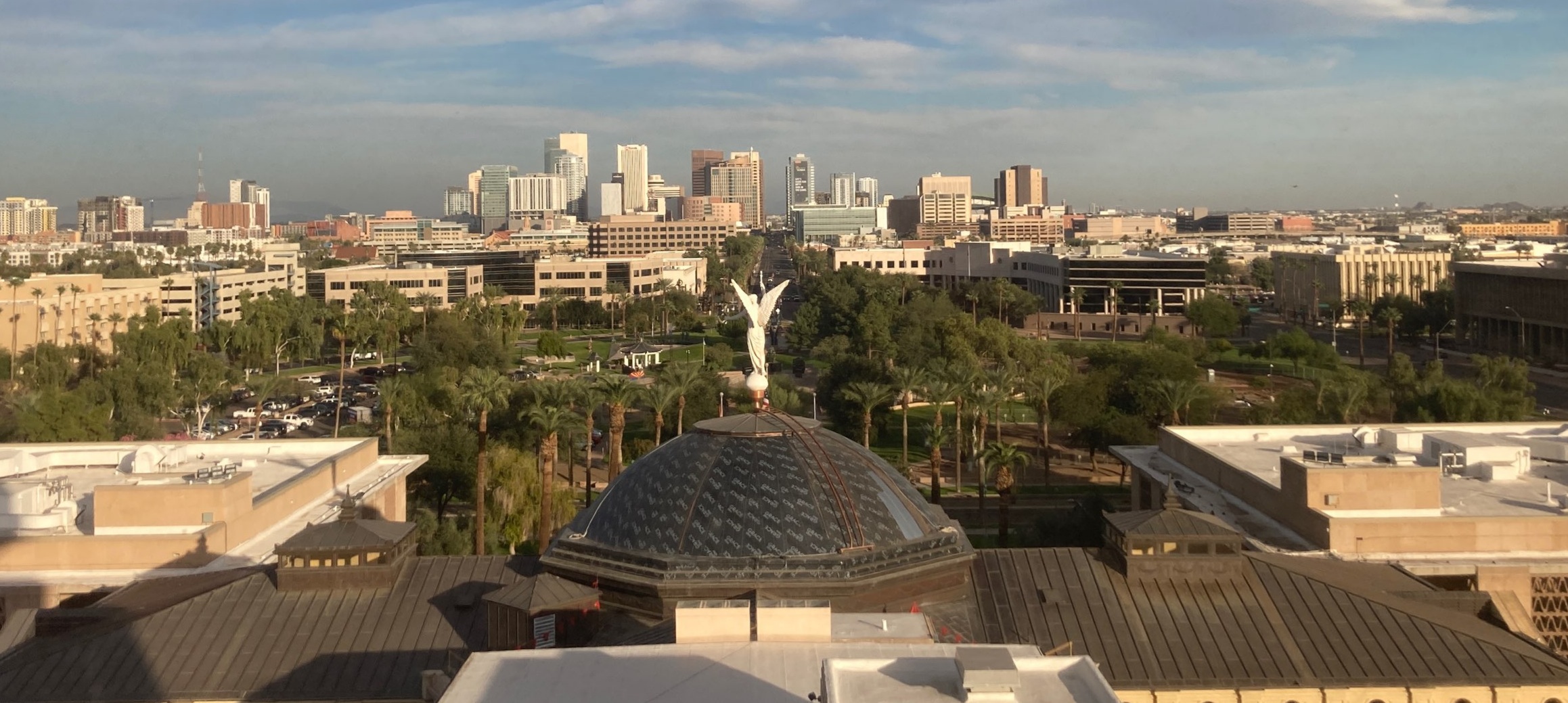New Copper Roof Adorns Historic Arizona Capitol

 January 20, 2022 - The glistening copper dome atop the historic Arizona state capitol building has been restored to the grandeur originally envisioned, this time for real and hopefully for a lot longer than the last time.
January 20, 2022 - The glistening copper dome atop the historic Arizona state capitol building has been restored to the grandeur originally envisioned, this time for real and hopefully for a lot longer than the last time.
New sheets of copper plating were installed on the distinctive dome of the building that opened in 1901 as what was then the territorial capitol. About 2,500 pounds of copper, some of it likely from Freeport-McMoRan mines in Arizona, were used in the restoration, which cost about $870,000 and was completed in December.
The copper-plated dome pays homage to the copper mining industry, which is integral to Arizona’s history and economy.
“It’s the iconic vision of the state capitol, 120 years ago and today,” said Mike Braun, Executive Director of the Arizona Legislative Council, the research and support arm of the Legislature which controls the old capitol building. “It’s called the capitol copper dome. It just seemed that the authenticity of the material was important symbolism.”
While that sentiment always has been there, the execution has been lacking somewhat since the stone-faced building opened more than 120 years ago in Arizona’s capital city of Phoenix, just down the street from Freeport-McMoRan’s current corporate headquarters building.
The original copper roof was something of a fake. It was faced with terne metal, sheet steel coated with a lead and tin alloy, and then painted to look like copper.
That bit of deception lasted until the mid-1970s, when a genuine copper roof was installed for the first time.
Losing its luster
That roof lasted until it was severely damaged in a 2010 hailstorm and was replaced in time to showcase the historic building during the state’s centennial celebration in 2012.
But the luster of the new copper dome quickly faded. Soon the shiny metal darkened, eventually turning black and corroded. It’s not really known why.
“It didn’t age well over the past decade, and we want it to be something that all Arizonans can be proud of,” said Megan Rose, Director of Statewide Communications for the Arizona Department of Administration, the agency in charge of the restoration. “It means something. It represents the fact that we are the copper state.”
This time, the copper was sealed at the factory, lessening the chances of corrosion, Rose said. The new roof should last many decades, she added.
It is likely that much of the copper used to replace the dome came from Freeport mines in Arizona, but there is no way to be sure, said Stacy Rubio, owner of Western States Metal Roofing, which supplied the materials for the job. Rubio’s company buys its copper in huge rolls from mills in the east, which obtain it from multiple sources and melt it all together, she said.
Rubio posed the question to her suppliers, and they concurred with her assessment.
“There’s a high probability that it came from some of the mines in Arizona, but they can’t say for sure because it comes from all over,” she said.
Copper’s colorful color combinations
As to the mystery of why the old roof corroded so quickly, the culprit most likely has something to do with the sealer and whether the dome was maintained properly, said Brad Wesstrom, Senior Process Engineer at Freeport’s El Paso operations.
Copper naturally will take on a patina, which is a very thin layer of oxidized compounds, if not treated to preserve its shiny appearance.
It can turn any number of different colors – green, red, blue, purple, brown or black – depending on temperature, rainfall and the chemical compounds in the air.
The dome in Phoenix is surrounded by an urban atmosphere with concentrations of things like sulfur, carbon and other elements associated with automobile emissions which, through oxidation, tends to turn untreated copper dark brown or black, Wesstrom said.
The alternative to replacing the copper would have been to strip off the old patina with chemical cleaning, or just leave it alone to naturally continue to oxidize, which ultimately would have left it with a distinctive greenish color.
“It’s a phenomenon that is going to happen unless you put a protective coating on it or you decide to just let it go its natural course,” Wesstrom said. “Eventually that dome would have changed to a green color. It might have taken 30 or 40 years, but there’s enough chlorides in the air that eventually it would have started to patina to a greener color. It’s just time, and did they want to wait that long?”

Photos (top to bottom): The copper dome atop the historic Arizona State Capitol building was replaced to restore it to its glistening grandeur; The old copper sheeting on the Capitol dome was removed starting in October.



 BACK
BACK
SOCIAL
RECOGNITION